A New Year’s Eve dinner in Shanghai
Writer Shen Jialu reminisces about Chinese New Year dinners during his childhood in Shanghai and takes us on a gastronomical journey involving festive regional dishes, specialities and traditions.
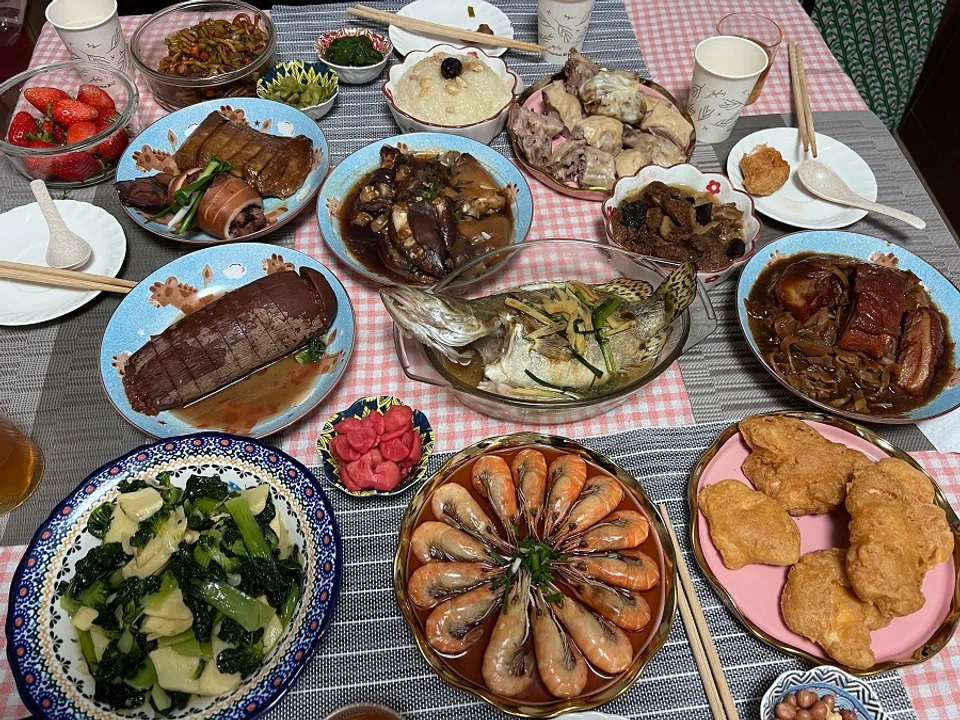
New Year’s Eve dinner is a deeply significant family gathering for Chinese people, symbolising reunion and happiness. On the night of New Year’s Eve, scores of people return home to their parents, no matter how far away they live or work. After greeting their parents, they offer incense, kowtow and present gifts to them, and pray to their ancestors for blessings. The glow of countless lights and the clinking of glasses as families gather for reunion dinner are some of the warmest moments in the world.
Shanghainese New Year delicacies
Shanghai is a city of immigrants, and the daily lives and eating habits of its people are deeply influenced by diverse cultures. For example, our ancestral home is Keqiao district in Shaoxing city, Zhejiang province. As a child, my favourite parts of the New Year were, of course, new clothes and red packets, and the hometown dishes I never tired of. Even during the planned economy era, when supplies were scarce, my resourceful mother would think of ways to prepare three signature New Year dishes: braised pork with bamboo shoots, pork stewed with preserved mustard greens, and yellow croaker salted fish braised with pork — all of which were cooked and served in clay pots.
Shanghainese homemakers also prepare a few vegetarian dishes, such as fried dough sticks with soybean sprouts. The heads of the soybean sprouts bend downward, earning them the nickname “ruyi vegetables” (如意菜, symbolising good luck and wishes).
These three clay pot dishes, rich in oil and sauce, had to be prepared by the day before New Year’s Eve and placed on the windowsill in the breeze, allowing a white layer of congealed fat to form on the surface. Their colours were vibrant, and their flavours rich and aromatic. Even if unexpected guests arrived at mealtime during the holiday, my mother would never panic. She would simply scoop a bowlful from each pot, reheat them and serve the guests.
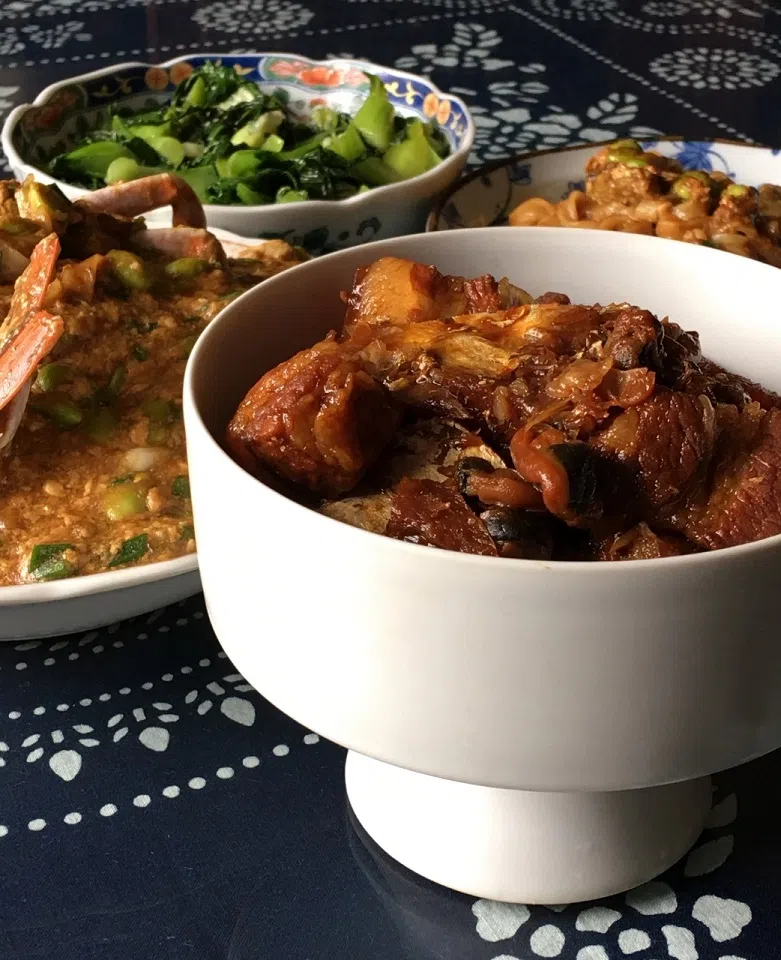
Shanghainese homemakers also prepare a few vegetarian dishes, such as fried dough sticks with soybean sprouts. The heads of the soybean sprouts bend downward, earning them the nickname “ruyi vegetables” (如意菜, symbolising good luck and wishes). There are also sprouted beans 发芽豆, known as “one-legged crabs”, which have a fresh, delicate taste, suitable both for pairing with alcohol and with rice.
Another essential dish for the New Year’s Eve feast is “four delights roasted gluten” (四喜烤麸). During my childhood, roasted gluten was available through coupons as a soy product, but it is actually made from wheat. After fermentation, it forms a large block, and when bought, the women carefully shred it with deft hands (cutting it with a knife would be untraditional). The pieces are fried briefly in oil to remove moisture, then combined with day lily, mushrooms, black fungus and a handful of peeled peanuts. The dish is seasoned liberally with soy sauce and sugar to infuse the dish with flavour, before sesame oil is drizzled on top to complete this classic New Year treat. The name “roasted gluten” (烤麸, kaofu) is also a homophone for “relying on one’s husband”, adding a layer of traditional cultural significance to the dish.
My family also prepares chicken braised in shrimp oil. If relatives from the countryside send us a plump capon, my mother would ask me to buy a bottle of shrimp oil extract from the Shaowansheng store on Nanjing Road. The chicken is boiled and cooled in the white-cut chicken (白斩鸡) style, while the broth is then mixed with the entire bottle of shrimp oil extract, along with Sichuan peppercorns, ginger, spring onions and yellow wine. This mixture is brought to a boil and poured into a rough clay pot to cool.
Better-off families may also prepare soy-braised pork, salted meats, wind-dried chicken and salted eel, dishes that dominate the dinner table and serve as perfect accompaniments to alcohol.

Once cooled, the chicken is chopped into large pieces, immersed in a marinade, and sealed in a jar for a day. When the jar is opened, a delightful fragrance wafts into the air. The shrimp oil-braised chicken is salty yet fresh with a lingering sweet aftertaste, perfect for pairing with both rice and wine. The shrimp oil can also be used to braise pork belly, pig’s stomach or pig’s intestines. Once the ingredients are finished, the marinade should not be thrown away. A spoonful added to cabbage soup will magically make the broth incredibly flavourful.
Families from Zhenjiang and Yangzhou would always prepare a clay pot filled with braised lion’s head meatballs, which, after freezing, are reheated with napa cabbage or leafy greens
Other common Chinese New Year dishes
Better-off families may also prepare soy-braised pork, salted meats, wind-dried chicken and salted eel, dishes that dominate the dinner table and serve as perfect accompaniments to alcohol. Families from Ningbo can bring the best New Year rice cakes, glutinous rice dumplings, salted eel, mud snails and salted crabs from their hometowns, much to the envy of neighbours. Cantonese families excel at making sausages and cured meats, often adding a few plates of rice cakes and turnip cakes.
Families from Zhenjiang and Yangzhou would always prepare a clay pot filled with braised lion’s head meatballs, which, after freezing, are reheated with napa cabbage or leafy greens. Some families also fry a tall stack of sesame oil fritters, which are served with tea to guests during the first month of the new year. Shandong families are known for steaming several baskets of buns, most of which are tightly packed flower-shaped buns. The large steamed buns, combined with braised pork, are enjoyed until the fifteenth day of the new year.
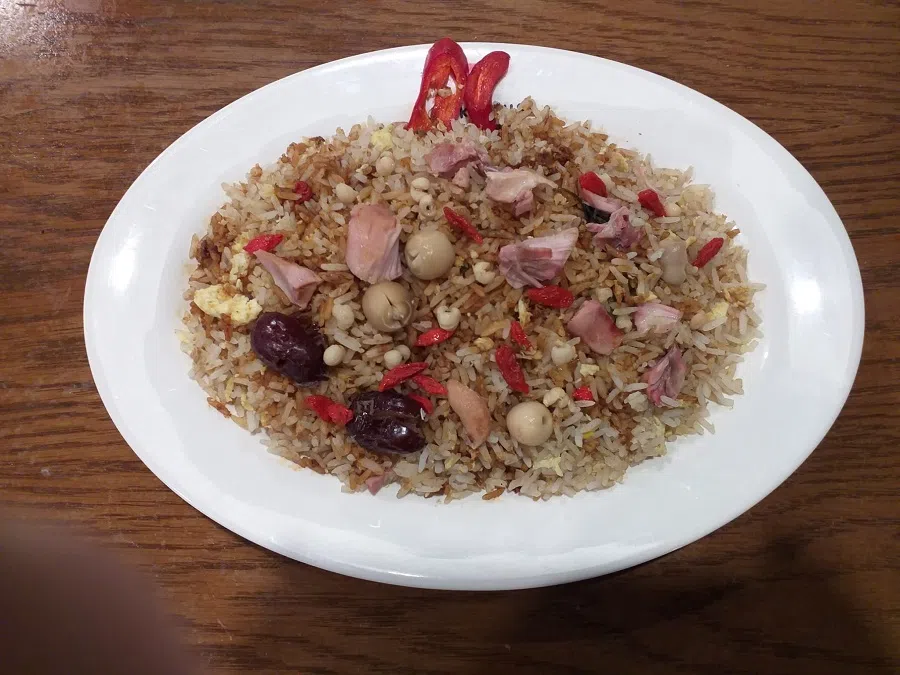
Shanghai’s alleyway households also prepare enough spring rolls, rice cakes, tangyuan (glutinous rice balls), and eight-treasure rice.
Spring rolls are filled with minced pork and shepherd’s purse or yellow cabbage, then deep-fried to a golden brown and served with vinegar. The sound of everyone enjoying and crunching on the spring rolls, resembling little gold bars, is truly heartwarming.
Shanghai people also eat nian gao (年糕 or rice cakes) during the New Year, as they symbolise “rising year after year” and carry hopes for happiness and prosperity. Nian gao can be served as a main dish when boiled in a soup with minced pork, or when stir-fried with ingredients like yellow cabbage, shepherd’s purse or minced pork. Sweet nian gao, like those served in fermented rice wine soup, make for a simple dessert. The prevalence of nian gao reflects the rice-based agricultural civilisation of Jiangnan, much like how people in northern China eat dumplings as part of their wheat-based traditions.
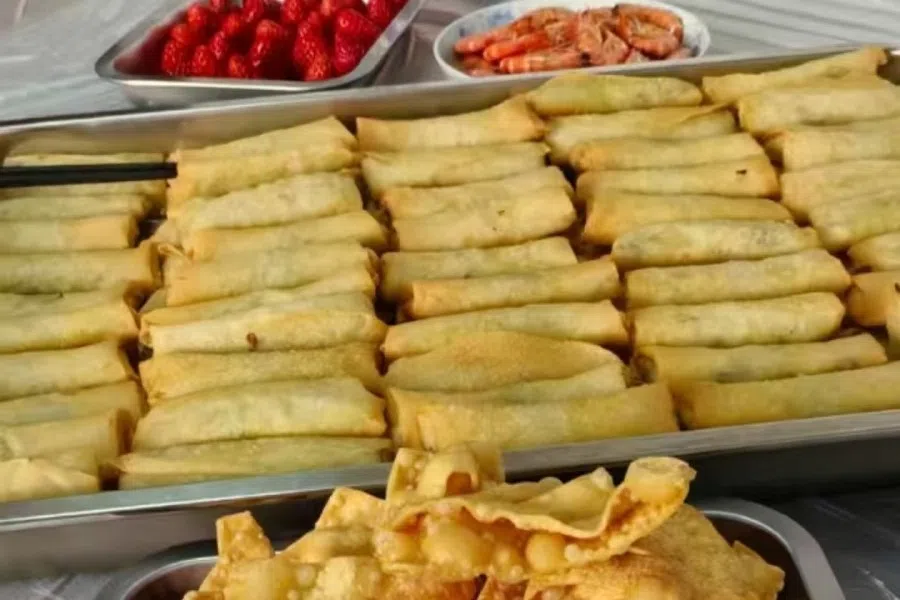
Tangyuan is also a popular dish, though fillings vary by region. During the New Year, the Shanghainese also enjoy Ningbo-style tangyuan filled with lard and black sesame paste. People in Pudong favour savoury tangyuan stuffed with vegetables and meat, which are usually served four per bowl. They are absolutely delicious. Families from Anhui, meanwhile, enjoy tangyuan filled with fresh meat.
The Shanghainese also have a deep affection for eight-treasures sticky rice pudding, a dessert made with glutinous rice and various sweet toppings. The best versions come from old establishments like Qiao Jia Shan, Wang Jia Sha, Shen Da Cheng, Xing Hua Lou and Xin Ya. At the end of a New Year’s Eve dinner, this dessert is a delightful finale. Everyone gets a spoonful — the perfect way to conclude the feast.
Local families might also prepare beancurd skin rolls stuffed with shepherd’s purse and minced pork, commonly called “quilts”. After cooking, the rolls are sliced, revealing the red-and-green filling.
A Shanghai-style New Year’s Eve feast
The New Year’s Eve feast in Shanghai homes usually starts with an array of cold dishes, such as white-cut chicken, soy-braised duck, smoked fish, century eggs, fried shrimp, jellyfish (strips or heads), pork belly slices, mud snails, spicy pickled cabbage, sweet and sour pork ribs, and cucumber with garlic sauce. Local families might also prepare beancurd skin rolls stuffed with shepherd’s purse and minced pork, commonly called “quilts”. After cooking, the rolls are sliced, revealing the red-and-green filling.
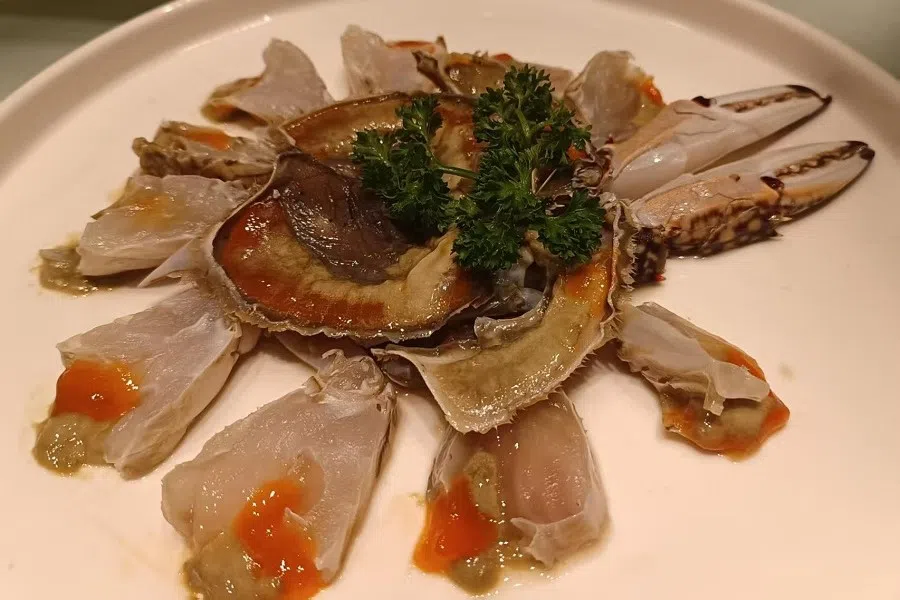
For families with more refined tastes, additional specialities such as drunken crabs, scallops, preserved eggs in rice wine, wind-dried goose, and salted eel might also be served, impressing any guest.
The lineup of hot dishes is quite impressive. Stir-fried shrimp is absolutely essential — in the Shanghainese dialect, the word for shrimp (hu ning) sounds like “welcome” (hui ning). As the opener, it is light, refreshing and loved by all ages.
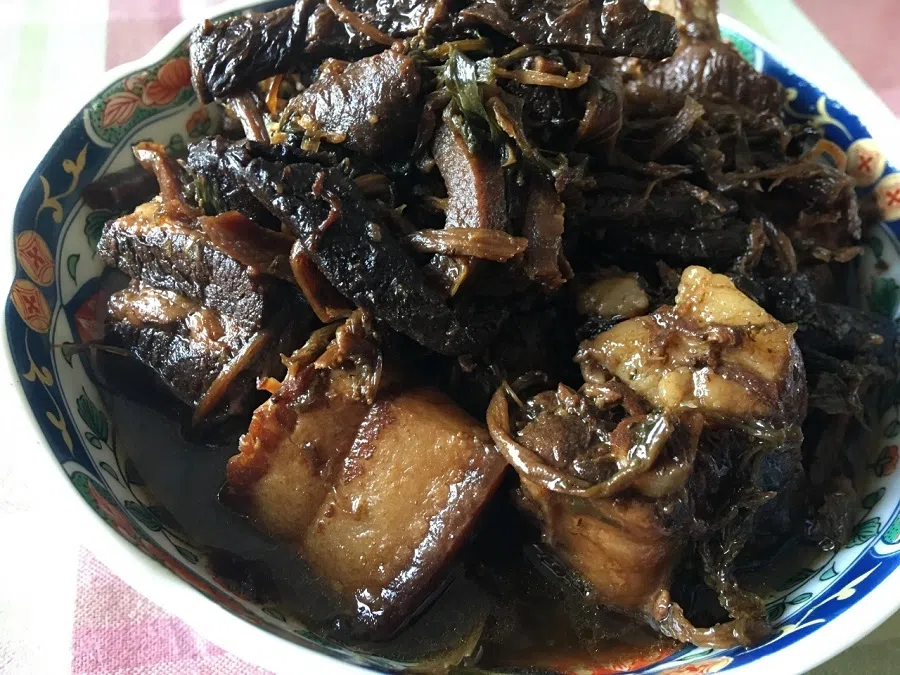
Following this, dishes like sweet and sour pork, oyster sauce beef, spicy chicken, wine-braised fish slices, stir-fried pork kidneys with scallions, braised sea cucumber with scallions, eight-treasure duck, stir-fried dried cuttlefish with pickled vegetables, and stir-fried winter bamboo shoots with mustard greens are some commonly served dishes. Then comes braised pork knuckle: back in the day when people had less access to rich food, the arrival of a substantial dish like braised pork knuckle would enliven the atmosphere.
Finally, there has to be fish — a whole fish, complete with head and tail, which is steamed or cooked in a sweet-and-sour sauce. Regardless, the fish is devoured in the blink of an eye. So much for leftovers symbolising abundance — at the time, eating one’s fill was the priority.
Quan Jia Fu: the grand finale
The finale is an assorted clay pot stew, known as Quan Jia Fu (全家福). Preparing this dish requires gathering a variety of ingredients in advance. The basics include meatballs, fish balls, fried fish slices, egg dumplings, pig trotters and rehydrated pork skin.
Making meatballs is straightforward, but fishballs are more difficult. Typically, a grass carp is split in half, and the meat is scraped from the back of the fish. This meat is minced into a paste with the back of a knife, mixed with water to achieve the right consistency, and seasoned with salt and pepper. Small portions of this mixture are squeezed from the thumb and forefinger to form the fishballs, which are dropped into boiling water. Once the fish balls float, they’re scooped out.

While it sounds simple, achieving perfection is challenging, so many people opt to buy ready-made fish balls from the market. However, I learned the technique from my mother. Once, while hosting two French Michelin chefs at home, I served a bowl of clear fish ball soup. The two handsome Frenchmen were full of praise for the dish!
The leftover fish meat can be used to make fried fish slices (爆鱼), to be paired with alcohol, or to add colour to the stew.
Making egg dumplings is a playful activity; many Shanghai men would have done it as children. The tool used to make the dumplings is a long-handled metal spoon, heated over a coal stove. A bit of raw pork fat is used to grease the spoon, and then a spoonful of beaten egg is poured in and swirled to form a thin egg wrapper. A pinch of minced pork is added to the centre of the wrapper, before the sides of the wrapper are folded over to form a half-moon shape. The dumpling is briefly cooked until golden. In one afternoon, one could make 50 to 60 egg dumplings. With their golden hue, egg dumplings bring festive cheer to the Quan Jia Fu.
... the hot pot is not placed on the stove until the second half of the family feast, after the whole chicken and duck have been eaten. Quan Jia Fu has to be bubbling and steaming when served, which creates a lively atmosphere.
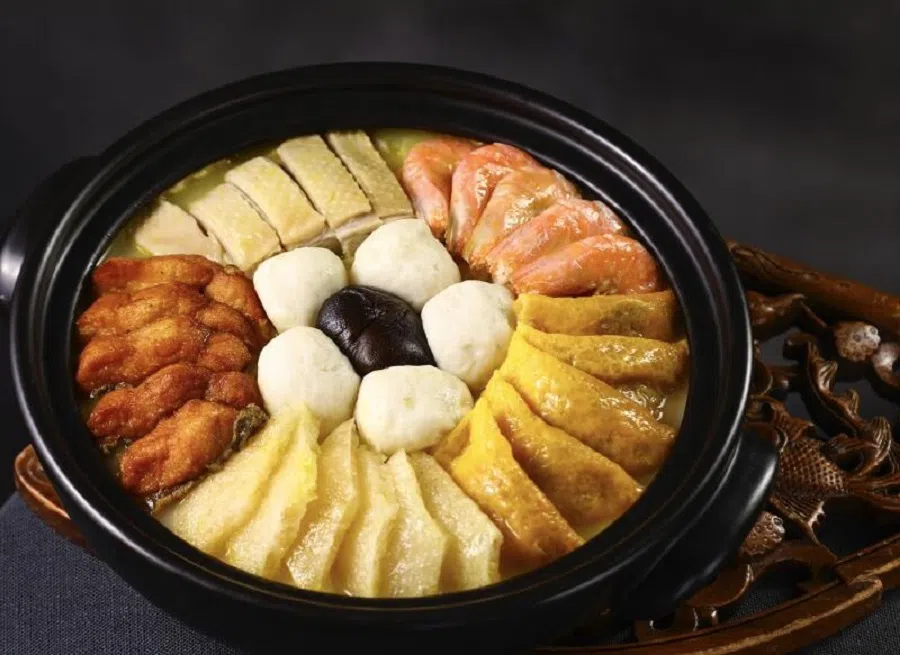
The first step is “building the stage”. The bottom of the clay pot is lined with napa cabbage or spinach, followed by a layer of soaked vermicelli. The top layer features the prepared ingredients — meatballs, fishballs, egg dumplings, fried fish slices, pork skin, and so on. With today’s abundant resources, families often add sea cucumber, abalone, quail eggs, shrimp balls and squid rings, carefully arranging them for presentation.
Chicken broth or meat stock is poured over the layers; but the hot pot is not placed on the stove until the second half of the family feast, after the whole chicken and duck have been eaten. Quan Jia Fu has to be bubbling and steaming when served, which creates a lively atmosphere.
When the stew is served, guests are sure to politely say: “There was such a spread today, but I simply must have a bowl of Quan Jia Fu!”
I have had Quan Jia Fu at the home of my Cantonese neighbours, and they always add a small pinch of fa cai (black moss) to the top of the dish. While fa cai doesn’t taste particularly good or look very appealing, it is there for its auspicious meaning, as fa cai sounds like “wealth” (发财). Some families also sprinkle a dozen or so goji berries into the soup. While they do add a pop of colour, I am not partial to them as they tend to alter the dish’s flavour.
Festive decor: fruits and flowers
What fruits and flowers should one prepare for the New Year? Influenced by Jiangnan culture, Shanghainese families are quite particular about the fruits and flowers they display during the Spring Festival. Common fruits include golden silk dates and a selection of fragrant citron fruits like Buddha’s hand citrons, pomelos, and lucky mandarin oranges. These are carefully selected for their visual appeal and arranged in lacquered wooden trays, giving off a faint aroma and a sense of elegance.

The fresh flowers displayed in the living room should also be seasonally appropriate: auspicious favourites include daffodils, kumquat trees, lucky bamboo, orchids, pussy willows, and wintersweet. Nowadays, moth orchids — also an auspicious choice — are also popular. Daffodil flowers are traditionally displayed in oval-shaped pots, with a red paper ribbon tied around their stems. This keeps the leaves upright and also adds a festive touch.
However, azaleas are never displayed, no matter how beautifully they bloom, as they are associated with the sorrowful imagery of cuckoo birds crying tears of blood. In recent years, some families have started placing a bundle of purple sugarcane by their door to symbolise rising prosperity.

On the morning of the first day of the Lunar New Year, if you go and drink tea at the Huxin Pavilion near Chenghuang Temple, the tea master will serve you Yuanbao Tea (“Ingot Tea”). Along with the tea, two pieces of sandalwood-flavoured Chinese olives will be served atop a fine porcelain saucer rimmed with gold. These olives, resembling gold ingots, carry the auspicious meaning of wealth. Known as dafu guo 大福果 or qing guo 青果 (green fruit), they are also phonetically similar to the Mandarin words for “please come over” (请过来). Upon receiving the tea, it is customary to tip the young attendant. The tea master will then announce: “Mr Zhang has drunk Yuanbao Tea — may he embrace a large ingot (great wealth) in the new year!”
The essence of the Spring Festival is embodied in these simple pleasures, with each dish and cup conveying everyday charm while also embodying hopes for a prosperous, abundant and joyful year ahead.
This article was first published in Lianhe Zaobao as “春节家宴乡味浓”.





